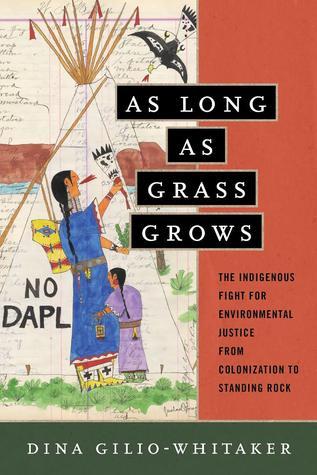Book: As Long As Grass Grows: The Indigenous Fight for Environmental Justice, from Colonization to Standing Rock by Dina Gilio-Whitaker
Genre: Nonfiction
Publisher: Beacon Press
Publication date: 2019
Pages: 212
Source: Hardcover book from library
 Summary: The title, As Long As Grass Grows, comes from the painful irony of this quote:
Summary: The title, As Long As Grass Grows, comes from the painful irony of this quote:
You are now in a country where you can be happy; no white man shall ever again disturb you; the Arkansas [River] will protect your southern boundary when you get there. You will be protected on either side; the white shall never again encroach upon you, and you will have a great outlet to the West.
As long as water flows, or grass grows upon the earth, or the sun rises to show your pathway, or you kindle your camp fires, so long shall you be protected from your present habitations.
-President James Monroe's speech to the Cherokees, 1817
This book first grounds us in Environmental Justice theory, a concept that developed around the 1970s. But, as illustrated by the above quote, Indigenous peoples in the United States experienced environmental injustice long before then. Colonizing settlers paid no attention to how things were done in a world that was new to them and, instead, imposed standards of land use that they knew from their old world. With an unwarranted sense of superiority, they destroyed practices that had served generations of people who already lived and engaged with this land.
This book describes what happened to the people who lived here in detailed stories about loss of land and culture.
But it turns out, that it's wrong to think of all of this as history - a mistake that I was taught in a thousand direct and indirect ways. Later chapters cover efforts of the last fifty years to recover and protect the spaces that are sacred to living American Indians and the sovereign nations to which they belong. These efforts are often hampered by white allies who still step into the space with a sense of learned superiority, of believing that we know what is best without consulting with and appreciating the people who are most impacted.
Thoughts: Our book group read this book in November for Native American Heritage Month. This book group specializes in race in America. Due to our history and community, most of the books that we've read in our 14-year history have been about the black and white experiences of race. Recently, we've been making an effort to diversify that.
I believe this is our third book to cover the experience of Indigenous peoples in the US, after Braiding Sweetgrass by Robin Wall Kimmerer and An Indigenous Peoples' History of the United States by Roxanne Dunbar-Ortiz.
Looking at the topic of white supremacy through a different lens helps me see more clearly. This book, in particular, challenged me with concepts that I thought I understood, but it turns out that I still have more to learn. I still show up in the world in ways that aren't as respectful as I mean to be. To truly respect another culture, I have to remember that my culture is important to me, but it doesn't take priority over anyone else's, especially in places like Standing Rock where the local customs should be respected.
At the same time, it's not respectful to borrow from other cultures and take the bits and pieces that I like to form my identity. I cringed while reading about the 1980s in this book. There were things that I absorbed in the ethos when I was in my twenties that look like appropriation when I think about it now.
I sometimes find myself in a state of despair that we can't fix all the things that white supremacy broke for the descendants of the people who were living here when colonist settlers arrived. That's a despair that leads to inaction. This book reminded me that no one is asking me to fix everything that broke. They're asking me to pay attention to what is going on now and to participate in the hope and promise that forms the last lines in this book:
".... effective partnerships with allies in the environmental movement will provide the best defense for the collective well-being of the environment and future generations of all Americans, Native and non-Native alike. In the long run, environmental justice for American Indians is environmental justice for everyone...and for the Earth herself." (p. 162)
 Appeal: This book is more academic than we anticipated, but it's short. Even reading a little slower than usual, this only took me a little over a week to read. It's definitely worth the effort if you care about the environment, the history and present of American Indians, or the future of all of us.
Appeal: This book is more academic than we anticipated, but it's short. Even reading a little slower than usual, this only took me a little over a week to read. It's definitely worth the effort if you care about the environment, the history and present of American Indians, or the future of all of us.
Challenges: This will likely be my final book for the 2022 Diversity Reading Challenge. I'm already looking forward to next year's challenge.
Have you read this book? What did you think?


About Joy Weese Moll
a librarian writing about books
